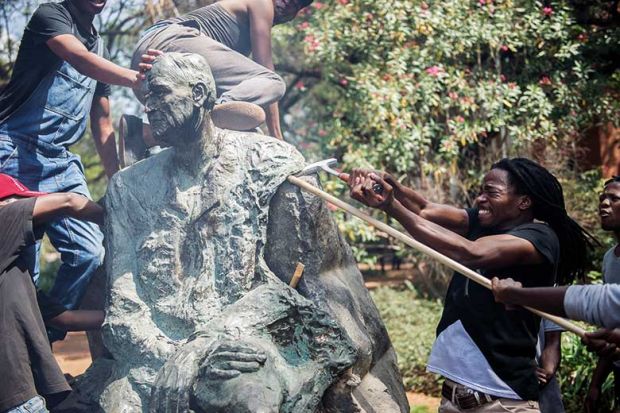The Victorians were prolific builders of all sorts of things, from houses to industries to overseas territories. They were also very fond of statues, and since the architects of colonialism were among the most revered figures of the time, public spaces and institutions in Britain are littered with Victorian imperialists memorialised in bronze.
That some of these figures are problematic in 2016 hardly needs saying. Take the example of King Leopold II of Belgium, who until earlier this year was commemorated twice at one London university (the plaques were removed after a student campaign). Leopold is now infamous for the cruelty in his “Congo Free State”. Children had hands cut off when their fathers failed to produce enough rubber for agents running the country as a private work camp. Millions died in the legacy of violence.
It’s a no-brainer, then, that such men should have their pigeon-spattered busts removed from whatever campus plinths they occupy. Or is it?
This, of course, is the intractable question as campaigns such as Rhodes Must Fall have argued over the place of history and honour in universities. In our cover story this week, we take an in-depth look at the issue, and hear a spectrum of views from the UK to South Africa, the US to Australia.
The students who say that these memorials must be removed have powerful arguments at their disposal. Would white Europeans tolerate statues of Hitler remaining on the streets of Berlin?
Scholars who support their position have alternative lines of attack: to what extent has a rosy view of British colonialism, for example, contributed to the nationalist swing illustrated by this summer’s Brexit vote and the anti-foreigner sentiment that has bubbled to the surface?
Others, however, point out that pulling down a statue “will not last long in the collective memory”, and that their continued presence on campus allows historical facts – no matter how unsavoury – to remain part of the discussion as successive generations of students spend a little time in their company.
The opposing arguments are also made that it’s not enough simply to accept that these figures were “men of their time”, and that it’s possible for men who did bad things not to have been wholly bad.
And to pose a related question, how in years to come might we view the modern-day equivalent of statue-building: the naming of university buildings, often after very wealthy donors with the complex backgrounds shared by many of the super-rich?
That there are no easy answers to these questions is a headache for university administrators, but it’s arguably a boon for the vigour of university and scholarly life.
Wole Soyinka, the Nigerian Nobel laureate (who spoke at Times Higher Education’s recent BRICS and Emerging Economies Summit in Johannesburg), tells a story about his student days at Churchill College, Cambridge, during a period of political exile.
Each morning he would pass a bust of Winston Churchill, colonialist extraordinaire, on the staircase, and every time he passed it, he says, he “had an overwhelming desire to push it and watch it crash”.
He has described this aggravation as a “triggering mechanism” for the outpouring of literary brilliance that followed. If universities are anything at all, they are places where students are provoked, challenged, inspired to demand change and to make their voices heard. It’s not why those Victorian statues were erected, and for those who would remove them not a reason for them to stay; but as long as they’re with us, at least they’re contributing as a catalyst of sorts.
Register to continue
Why register?
- Registration is free and only takes a moment
- Once registered, you can read 3 articles a month
- Sign up for our newsletter
Subscribe
Or subscribe for unlimited access to:
- Unlimited access to news, views, insights & reviews
- Digital editions
- Digital access to THE’s university and college rankings analysis
Already registered or a current subscriber?


